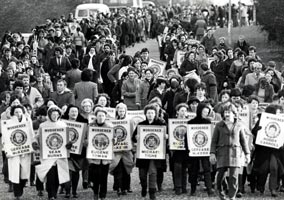La polizia chiede altro tempo per la consegna dei rapporti segreti sugli incidenti relativo al cosiddetto shoot-to-kill avvenuti negli anni Ottanta

La richiesta verrà valutata in tribunale alla fine di questo mese.
Sei persone morirono in situazioni controverse, uccise dalla Royal Ulster Constabulary. Tra di loro anche alcuni membri dell’IRA.
L’indagine sulla volontà di uccidere queste persone da parte della polizia (senza nemmeno cercare di arrestarle, NdT) fu condotta dall’ex vice comandante della polizia di Gretaer Manchester, John Stalker, e da Colin Sampson della West Yorkshire Police.
I loro rapporti non sono mai stati resi pubblici.
In un comunicato, la polizia dichiara di essere “deplorevolmente” incapace di rispettare la scadenza a causa della mole di materiale da analizzare e “delle complesse problematiche da affrontare”.
Il comunicato aggiunge: “La PSNI desidera nuovamente mettere in rilievo la propria volontà di collaborare pienamente con il Coroner (medico legale) e continua a lavorare il più alacremente possibile con un comprensibile esercizio di rivelazione che coinvolge una esauriente valutazione dei rischi per la sicurezza nazionale e considerazioni sulla questione dei diritti umani”.
A settembre, Leckey aveva chiesto di rendere disponibili i rapporti Stalker e Sampson entro il 9 novembre.
Stava partecipando all’udienza preliminare sulla morte, avvenuta a Lurgan nel 1982, dei membri dell’IRA Eugene Toman, Sean Burns e Gervaise McKerr.
Leckey inviò il proprio ordine al comandante della polizia Matt Baggott.
Stava riproponendo la richiesta fatta a ottobre 2007 anche al precedente comandante, Hugh Orde.
In seguito emerse che i tre erano sospettati del coinvolgimento nella morte di tre agenti della RUC, causata dallo scoppio di una bomba avvenuto due settimane prima, e si trovavano sotto stretta osservazione.
Leckey ha anche pianificato per svolgere indagini sulle morti del giovane cattolico Michael Tighe, colpito a morte dalla polizia in un fienile vicino a Craigavon nel novembre 1982, e dei presunti uomini dell’INLA, Roddy Carroll e Seamus Grew, uccisi vicino ad Armagh nel dicembre 1982.
Il governo ha sempre negato l’esistenza di una politica di “shoot-to-kill” (sparare per uccidere) e ha sempre resistito alle richieste delle famiglie delle vittime per analizzare nuovamente cosa accadde.
L’indagine fu affidata all’ex comandante della polizia di Greater Manchester, John Stalker. Sostituito in seguito da Colin Sampson, della polizia di West Yorkshire.
Tratto da BBC News
PSNI stall on shoot-to-kill files
The police have asked for more time to hand over secret reports into so-called shoot-to-kill incidents in Northern Ireland in the 1980s.
The request will be considered at a court hearing at the end of this month.
Six people, including IRA members, died in the controversial shootings by the Royal Ulster Constabulary.
The investigation into whether the police set out to kill them was conducted by former Greater Manchester Police Deputy Chief Constable John Stalker and Sir Colin Sampson of the West Yorkshire Police.
Their reports have never been made public.
In a statement, the police said they were “regrettably” unable to meet the deadline because of the volume of material and “the complex issues involved.”
The statement adds: “The PSNI wishes to re-emphasise its willingness to co-operate fully with the coroner and continues to proceed as expeditiously as possible with a comprehensive disclosure exercise that involves a thorough evaluation of any risks to national security and consideration of human rights issues.”
In September, Mr Leckey asked for the Stalker and Sampson reports to be made available by 9 November.
He was speaking at a preliminary hearing into the 1982 deaths of IRA men Eugene Toman, Sean Burns and Gervaise McKerr near Lurgan, County Armagh.
Mr Leckey directed his order to release the reports to PSNI Chief Constable Matt Baggott.
He was repeating a demand he made to former Chief Constable Sir Hugh Orde in October 2007.
It later emerged the three were suspected of involvement in the killings of three RUC officers in a bomb a fortnight earlier and had been under observation.
Mr Leckey also plans to hold inquests into the deaths of Catholic teenager Michael Tighe, shot dead by police at a hay shed near Craigavon, County Armagh in November 1982, and suspected INLA men Roddy Carroll and Seamus Grew, shot dead near Armagh in December 1982.
The government has always denied any “shoot-to-kill” policy existed and has resisted calls from families to look again at what happened.
Former Deputy Chief Constable of Greater Manchester Police Sir John Stalker was brought in to investigate. He was later replaced by Colin Sampson, Chief Constable of West Yorkshire Police.